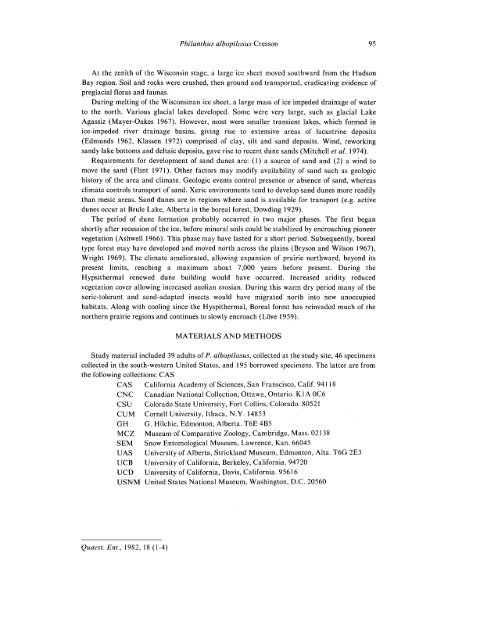Hilchie 1982 QEv18n1_4 91_126 CC released.pdf - College of ...
Hilchie 1982 QEv18n1_4 91_126 CC released.pdf - College of ...
Hilchie 1982 QEv18n1_4 91_126 CC released.pdf - College of ...
Create successful ePaper yourself
Turn your PDF publications into a flip-book with our unique Google optimized e-Paper software.
Philanthus albopilosus Cresson 95<br />
At the zenith <strong>of</strong> the Wisconsin stage, a large ice sheet moved southward from the Hudson<br />
Bay region. Soil and rocks were crushed, then ground and transported, eradicating evidence <strong>of</strong><br />
preglacial floras and faunas.<br />
During melting <strong>of</strong> the Wisconsinan ice sheet, a large mass <strong>of</strong> ice impeded drainage <strong>of</strong> water<br />
to the north. Various glacial lakes developed. Some were very large, such as glacial Lake<br />
Agassiz (Mayer-Oakes 1967). However, most were smaller transient lakes, which formed in<br />
ice-impeded river drainage basins, giving rise to extensive areas <strong>of</strong> lacustrine deposits<br />
(Edmunds 1962, Klassen 1972) comprised <strong>of</strong> clay, silt and sand deposits. Wind, reworking<br />
sandy lake bottoms and deltaic deposits, gave rise to recent dune sands (Mitchell et al. 1974).<br />
Requirements for development <strong>of</strong> sand dunes are: (1) a source <strong>of</strong> sand and (2) a wind to<br />
move the sand (Flint 1971). Other factors may modify availability <strong>of</strong> sand such as geologic<br />
history <strong>of</strong> the area and climate. Geologic events control presence or absence <strong>of</strong> sand, whereas<br />
climate controls transport <strong>of</strong> sand. Xeric environments tend to develop sand dunes more readily<br />
than mesic areas. Sand dunes are in regions where sand is available for transport (e.g. active<br />
dunes occur at Brule Lake, Alberta in the boreal forest, Dowding 1929).<br />
The period <strong>of</strong> dune formation probably occurred in two major phases. The first began<br />
shortly after recession <strong>of</strong> the ice, before mineral soils could be stabilized by encroaching pioneer<br />
vegetation (Ashwell 1966). This phase may have lasted for a short period. Subsequently, boreal<br />
type forest may have developed and moved north across the plains (Bryson and Wilson 1967),<br />
Wright 1969). The climate ameliorated, allowing expansion <strong>of</strong> prairie northward, beyond its<br />
present limits, reaching a maximum about 7,000 years before present. During the<br />
Hypsithermal renewed dune building would have occurred. Increased aridity reduced<br />
vegetation cover allowing increased aeolian erosian. During this warm dry period many <strong>of</strong> the<br />
xeric-tolerant and sand-adapted insects would have migrated north into new unoccupied<br />
habitats. Along with cooling since the Hyspithermal, Boreal forest has reinvaded much <strong>of</strong> the<br />
northern prairie regions and continues to slowly encroach (Love 1959).<br />
MATERIALS AND METHODS<br />
Study material included 39 adults <strong>of</strong> P. albopilosus, collected at the study site, 46 specimens<br />
collected in the south-western United States, and 195 borrowed specimens. The latter are from<br />
the following collections: CAS<br />
CAS California Academy <strong>of</strong> Sciences, San Franscisco, Calif. 94118<br />
CNC Canadian National Collection, Ottawa, Ontario. Kl A 0C6<br />
CSU Colorado State University, Fort Collins, Colorado. 80521<br />
CUM Cornell University, Ithaca, N.Y. 14853<br />
GH G. <strong>Hilchie</strong>, Edmonton, Alberta. T6E 4B5<br />
MCZ Museum <strong>of</strong> Comparative Zoology, Cambridge, Mass. 02138<br />
SEM Snow Entomological Museum, Lawrence, Kan. 66045<br />
UAS University <strong>of</strong> Alberta, Strickland Museum, Edmonton, Alta. T6G 2E3<br />
UCB University <strong>of</strong> California, Berkeley, California. 94720<br />
UCD University <strong>of</strong> California, Davis, California. 95616<br />
USNM United States National Museum, Washington, D.C. 20560<br />
Quaest. Ent., <strong>1982</strong>, 18(1-4)
















